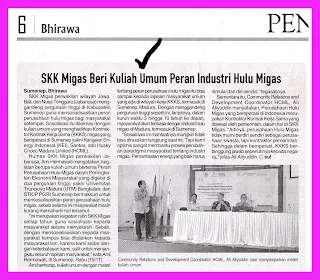State-owned electricity company PT Perusahaan Listrik Negara projected that liquefied natural gas (LNG) demand for electricity generation in 2018 will not be much different from this year's 51 cargoes.
Director of Strategic Procurement II PT Perusahaan Listrik Negara Supangkat Iwan Santoso said that in 2018 there is no new steam power plant (PLTGU) power plant operating so there is no additional LNG volume.
Based on data from the ESDM Ministry, this year there are 51 LNG cargoes allocated to PLN. The LNG cargo was acquired through five purchase contracts. First, a contract with BP Tangguh refinery of 16 cargoes is processed through regasification facilities
Arun Aceh.
Second, the LNG supply is received through a total purchase contract with Total in Mahakam Block as 4 cargoes which are classified through the Benoa gas facility in Bali. Third, the last three contracts are processed at Nusantara Regas's floating storage regasification unit (FSRU), which is the contract of purchase of LNG from BP Tangguh LNG Plant as much as 4 cargoes.
Fourth, the purchase contract with Bontang LNG Plant located in East Kalimantan is 17 cargoes. Fifth, LNG purchase contract from PT Pertamina as much as 10 cargoes from the oil and gas project in Deepwater Development (IDD) Bangka and Muara Bakau.
"It's about the same because the plant is the same. There is no additional, "he said.
According to him, the new regasification facility is not yet operational next year. Therefore, the supply of LNG in 2018 is still absorbed by existing regasification facilities such as Arun FSRU, FSRU Iampung, FSRU Nusantara Regas. In terms of power plants, LNG supply will still be absorbed by power plants in Tanjung Priok, Muara Tawar, North Sumatra and Arun.
NOT OPERATING
The new gas-fired power plant is expected to operate in 2020, namely PLTGU Java-1 which has obtained gas supply and Tangguh Train III LNG Plant. From PLN data, LNG demand for power plants is projected to increase every year.
LNG demand for power plants by 2018 is estimated at 310 billion cubic feet (Bcf) to increase to 358 Bcf in 2019 and 2020 to 419 Bcf. Then, in 2021 it drops to 416 Bcf and 2022 rises to 438 bcf.
Previously, Director General of Oil and Gas of EMR Ministry Ego Syahrial said that the absorption of LNG for PLN has not been optimum for the last 2 years.
In 2016, PLN LNG cargo absorption is around 75%. For 2017, Ego Syahrial said that the absorption of LNG in the range of 85%.
However, he did not specify the volume of allocation and absorption. For example, this year's LNG production target of 278 cargoes consists of 163 cargoes from the Bontang LNG Plant and 115 cargoes from the Tangguh Train of Papua.
"Over the last 2 years indeed the absorption of PLN may be down if not mistaken 2016 absorption 75%.
IN INDONESIA
2018, Volume LNG Tidak Bertambah
PT Perusahaan Listrik Negara memproyeksikan kebutuhan gas alam cair (liquefied natural gas/ LNG) untuk pembangkit Iistrik pada 2018 tidak akan jauh berbeda dengan tahun ini sebanyak 51 kargo.
Direktur Pengadaan Strategis II PT Perusahaan Listrik Negara Supangkat Iwan Santoso mengatakan bahwa pada 2018 belum ada pembangkit Iistrik tenaga gas uap (PLTGU) baru yang beroperasi sehingga tidak ada tambahan volume LNG.
Berdasarkan data Kementerian ESDM, pada tahun ini ada 51 kargo LNG yang dialokasikan kepada PLN. Kargo LNG itu diperoleh melalui lima kontrak pembelian. Pertama, kontrak dengan Kilang BP Tangguh sebanyak 16 kargo yang diolah melalui fasilitas regasifikasi
Arun Aceh.
Kedua, pasokan LNG diterima melalui kontrak pembelian dengan Total di Blok Mahakam sebanyak 4 kargo yang diregasifikasi melalui fasilitas gas Benoa di Bali. Ketiga, tiga kontrak terakhir diolah di fasilitas penyimpanan dan regasifikasi (floating storage regasification unit/FSRU) milik Nusantara Regas, yakni kontrak pembelian LNG dari Kilang LNG BP Tangguh sebanyak 4 kargo.
Keempat, kontrak pembelian dengan Kilang LNG Bontang yang berlokasi di Kalimantan Timur sebanyak 17 kargo. Kelima, kontrak pembelian LNG dari PT Pertamina sebanyak 10 kargo yang berasal dari proyek migas laut dalam (Indonesia Deepwater Development/ IDD) Bangka dan Muara Bakau.
“Kira-kira sama karena pembangkitnya juga sama. Belum ada tambahan," ujarnya.
Menurutnya, fasilitas regasifikasi baru pun belum beroperasi pada tahun depan. Oleh karena itu, pasokan LNG pada 2018 masih diserap fasilitas regasifikasi yang ada seperti FSRU Arun, FSRU Iampung, FSRU Nusantara Regas. Dari sisi pembangkit, pasokan LNG masih akan diserap unit pembangkit di Tanjung Priok, Muara Tawar, Sumatra Utara dan Arun.
BELUM BEROPERASI
Untuk pembangkit baru berbahan bakar gas diperkirakan beroperasi pada 2020, yakni PLTGU Jawa-1 yang telah mendapatkan pasokan gas dan Kilang LNG Tangguh Train III. Dari data PLN, kebutuhan LNG untuk pembangkit diproyeksi terus naik setiap tahun.
Kebutuhan LNG untuk pembangkit pada tahun 2018 diperkirakan 310 miliar kaki kubik (Bcf) naik menjadi 358 Bcf pada 2019 dan 2020 naik menjadi 419 Bcf. Kemudian, pada 2021 turun menjadi 416 Bcf dan 2022 naik menjadi 438 bcf.
Sebelumnya, Direktur Jenderal Minyak dan Gas Bumi Kementenan ESDM Ego Syahrial mengatakan bahwa penyerapan LNG untuk PLN belum optimum selama 2 tahun terakhir.
Pada 2016, penyerapan kargo LNG PLN sekitar 75%. Untuk 2017, Ego Syahrial menuturkan bahwa penyerapan LNG di kisaran 85%.
Kendati demikian, dia tidak menyebut secara rinci volume alokasi dan penyerapannya. Sebagai contoh, target produksi LNG tahun ini 278 kargo terdiri dari 163 kargo berasal dari Kilang LNG Bontang dan 115 kargo dari Train Tangguh Papua.
“Selama 2 tahun terakhir memang penyerapan PLN boleh dibilang turun kalau tidak salah 2016 itu penyerapannya 75 %.
Bisnis Indonesia, Page-30, Thursday, Nov 16, 2017










